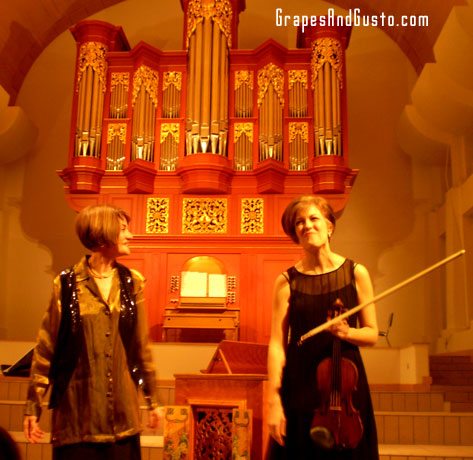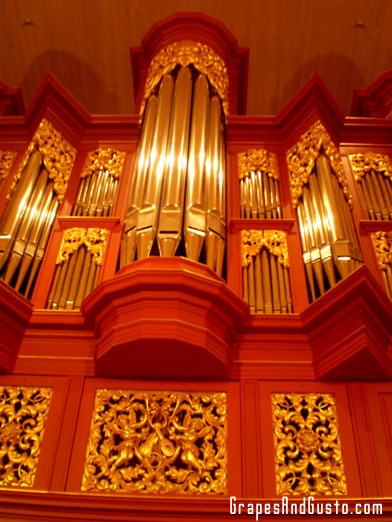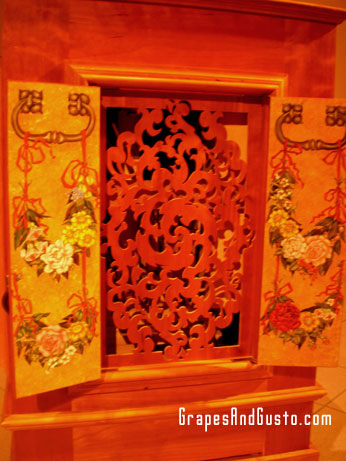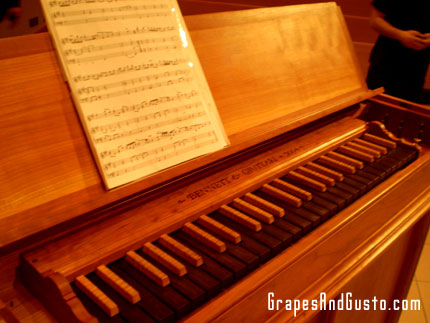
Katherine McLin (right, on a 1734 violin) and Kimberly Marshall (on pipe organ) mesmerize the audience at Arizona State University
There is something about a pipe organ. Something beautiful, something haunting (ok, I’ll say it – something even a bit creepy and foreboding). But something powerful, nevertheless. And the dreamlike sequence featuring Bach’s Toccata and Fugue in D Minor, in Disney’s Fantasia, certainly put organs back on the map when that film came out.
And violins…don’t get me started! Done right, the sound of a violin can (and has) literally moved me to tears. Or gotten me so pumped up for life that I wanted to jump up and go conquer something. The movie alone, The Red Violin, has spoken volumes of the timeless power of this poignant and emotionally-charged instrument. Even non-musicians have heard of the great Stradivarius and his priceless violins.
I was therefore delighted to discover a concert created just for the sake of pairing these two musical titans of sound. Arizona State University’s Herberger College of the Arts sponsors an impressive array of concerts – choral, jazz, orchestral, band, percussion, guitar…you name it, they have an in-house ensemble or a guest performance of it. In this case, I attended an afternoon concert yesterday at Organ Hall called Beauty and Bravura, featuring the violin – a 1734 Sanctus Seraphin violin, in fact – and the organ, a beautiful rendition built in the 1990s in the classic Baroque style.
Since musical instruments do not play themselves (barring those saloon pianos), the credit goes to the two stunning virtuosos who performed: Katherine McLin on the violin and Kimberly Marshall on the organ. Each woman has had an illustrious international musical career, impressive academic affiliations, and a cadre of classical recordings.
As I left the concert hall, I had the following thought: What if Bach had gotten caught up in his daily grind? What if he started dabbling with a few variations on a theme – maybe 5 or 6 max, instead of the 64 variations in his signature Passacaglia – but then life got in the way? There they’d be: unfinished manuscripts on his desk, gathering dust and coffee stains…What would his legacy have been? What would we have from him today? If we are serious about our own legacies, and realizing our gifts and potentials in this lifetime, let’s take our dreams seriously – turn them into goals (dreams with timeframes) and let’s get to the business of giving of ourselves to the world in the form of a legacy.

Detail of the pipe organ featured in the "Beauty and Bravura" concert at Arizona State University. The organ was built in 1991, but retains a classic Baroque flavor.
For the serious aficionados, here is a look at yesterday’s Beauty and Bravura program, along with commentary from yours truly:
Adagio and Fugue for the Violin and Organ, Op. 150, no. 6
Joseph Rheinberger (1839-1901)
This lively opening piece featured both McLin and Marshall, playing violin and organ side by side. Although a much later successor of Bach, composer Rheinberger included several distinctive riffs reminiscent of Bach’s signature swirly flourishes.
Partita No. 2 in D minor for Violin, BWV 1004
Ciaccona
Johann Sebastian Bach (1685-1750)
This was by far McLin’s showcase piece, both for her crisp expertise as a violinist, and for the piece itself. Prior to playing it, she explained to the audience that the Ciaccona was thought to have been Bach’s dedication to his wife when he learned of her death. The Ciaccona is nearly 15 minutes long – longer than the preceding four parts combined – and with McLin’s expert mastery of its haunting, lyrical components, the audience was transfixed. There was is eerie beauty to this piece that is almost surreal.
Sonata Representiva for Violin and Continuo
Heinrich Ignaz Biber (1644-1704)
Allegro
The Nightingale
The Cuckoo
The Frog
Adagio
Allegro: The Hen/The Rooster
Presto
Adagio: The Quail
The Cat
Mussquetir Mars
Allamande
Here, we heard a light-hearted contrast to the gravitas of the Ciaccona preceding it. Biber, who precedes Bach, created a rather amusing sonata centered on vignettes with particular animal themes. During The Hen/The Rooster segment, there was even a somewhat country-western flair at times, which was ironic since Biber was born in 1644. Perhaps it is now that the cowboy spirit lives on.
The other interesting feature of this piece was that Marshall did not play the organ, but instead, played an early musical instrument called the continuo. Prior to playing, she opened two ornate panels to let the sound travel better, and I was able to see, from my second-row seat, that the inside of the two panels was elaborately painted with flowers and ribbons. No plain packaging back then!

Here, the side panel of the continuo is visible, with hand-painted floral and trompe l'oeil detailing.
Passacaglia in C Minor for Organ, BWV 582
J.S. Bach
Ahhh…back to Bach. Call me a purist, or simply a Baroque fanatic, but I always come back to J.S. Bach and his tremendous capacity for combining mathematical order with music to create works that are far from robotic – but are in fact, sublime and complex while conveying passionate melodies. In fact, this passacaglia, played exclusively on the organ by Marshall, contained a total of 64 variations on a single, four-bar theme. This is not just a case of “well-someone-had-some-time-on-their-hands-snicker-snicker” – this is the mark of true genius!
Capriccio for Violin and Organ
Naji Hakim (b. 1955)
McLin and Marshall concluded the program with this vivacious number by modern-day composer Naji Hakim. There were a variety of elements to it, and a mixture of tempos. While my personal favorites reside in the Baroque era, I applaud the duo for the variety of their program, and for showcasing the wide range of abilities of themselves as performers, the ingenuity of the composers, and of their exemplary instruments.
Time to dust off the ol’ hobbies and see which ones we want to take to the next level.
© Gilat Ben-Dor, 2010. All rights reserved.

The black keyboard of the continuo played by Kimberly Marshall at Arizona State University


Recent comments